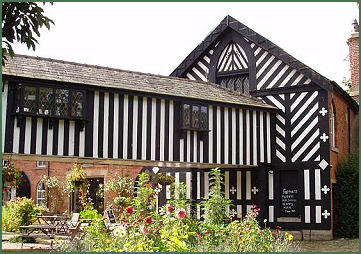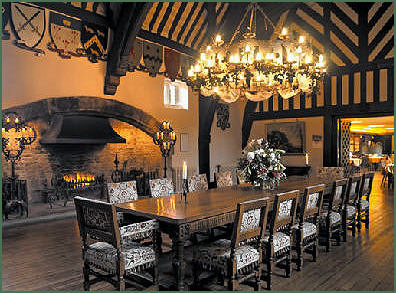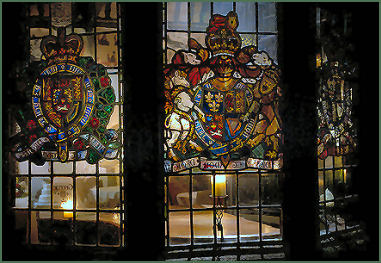Samlesbury Hall
OS Grid ref:- SD623304
 Picturesque Samlesbury Hall is situated in the small village of Samlesbury, in Lancashire, which lies around 6 miles to the east of Preston.
Picturesque Samlesbury Hall is situated in the small village of Samlesbury, in Lancashire, which lies around 6 miles to the east of Preston.
 The first hall to occupy the site was a timber house built by Gospatrick and destroyed during a Scottish raid in 1322 by soldiers loyal to Robert the Bruce, after the Battle of Bannockburn, when the Scots ransacked and pillaged homes along the banks of the River Ribble, from Preston to Clitheroe. At this time the hall was occupied by Robert de Holland who had married Elizabeth de Samlesbury, Gospatrick's grand-daughter. The treasures of both the church of St Leonard the Less and the Samlesbury old hall were plundered and the hall left in flames.
The first hall to occupy the site was a timber house built by Gospatrick and destroyed during a Scottish raid in 1322 by soldiers loyal to Robert the Bruce, after the Battle of Bannockburn, when the Scots ransacked and pillaged homes along the banks of the River Ribble, from Preston to Clitheroe. At this time the hall was occupied by Robert de Holland who had married Elizabeth de Samlesbury, Gospatrick's grand-daughter. The treasures of both the church of St Leonard the Less and the Samlesbury old hall were plundered and the hall left in flames.
The present hall was built by Gilbert de Southworth in 1325, possibly to replace the earlier building. He acquired the Salmesbury lands through his marriage to the heiress Alicia de Ewyas. Another Gilbert de Southworth appears to have fought at the Battle of Agincourt, the famous English victory on 25 October 1415. It is not known whether he survived that conflict. In around 1420, Sir Thomas Southworth was given permission to build a chapel at the hall , which is said to be dedicated to St. Michael. The Hall over time had additional constructions and outbuildings added by the Southworth family, Thomas de Southworth, Gilbert's great grandson, who fought in the battle of Flodden, built the west wing of the house, the oriel bay and the screen.
The Southworth's, a staunchly Catholic family, suffered a reversal of their fortunes when the protestant Queen Elizabeth I ascended the throne in 1558. Sir John Southworth was imprisoned for refusing to conform to reformed church practice. His son, John, a Catholic priest, was imprisoned in Lancaster Castle for three years from 1627 for promoting his faith. While the plague was decimating London in 1636, John tended four hundred Catholic sufferers, in 1654 he was hauled from his bed by Colonel Worsley, confessed that he had been converting people to Catholicism and was hung, drawn and quartered at Tyburn. Determined to adhere to their faith, secret Masses took place in the surrounding woods and the family installed no less then three Priest Holes in the hall. In the sixteenth century a Catholic priest was followed to the hall by soldiers and discovered hidden in one of the priest holes. He was dragged out and beheaded on the spot.
 Samlesbury Hall remained in the possesion of the Southworth Family until the early seventeenth century, when the payment of these fines incurred by John Southworth slowly ruined the estate and eventually Edward Southworth sold Samlesbury Hall to Thomas Braddyll on 10th March 1678.After this the building variously served as a girl's boarding school, a factory and a pub.
Samlesbury Hall remained in the possesion of the Southworth Family until the early seventeenth century, when the payment of these fines incurred by John Southworth slowly ruined the estate and eventually Edward Southworth sold Samlesbury Hall to Thomas Braddyll on 10th March 1678.After this the building variously served as a girl's boarding school, a factory and a pub.
The hall was saved from demolition in 1925 with money was raised by public subscription and since then has been administered by a registered charitable trust, the Samlesbury Hall Trust.
Steeped in fascinating history and retaining its original typical black and white exterior. The timber framing of the hall is decorated with striking quatrefoils, and the walls are made from wattle and daub infill. The main rooms in the building include a long gallery, minstrels gallery, and chapel, which contains a small Roman altar, which may have been found on Mellor Moor.
 The ghost of the seventeenth century Lady Dorothy Southworth is said to haunt the hall, Lady Dorothy, a sister of Sir John Southworth, and daughter of Sir Thomas and Margaret (nee Butler) his second wife, fell in love with a member the de Hoghton family from the neigbouring Hoghton Tower. The de Hoghtons were strongly Protestant and therefore the Southworth's would never consent to a union. The pair, nevertheless, continued to rendezvous in secret, meeting in the woods or near the banks of the Ribble and made plans to elope.
The ghost of the seventeenth century Lady Dorothy Southworth is said to haunt the hall, Lady Dorothy, a sister of Sir John Southworth, and daughter of Sir Thomas and Margaret (nee Butler) his second wife, fell in love with a member the de Hoghton family from the neigbouring Hoghton Tower. The de Hoghtons were strongly Protestant and therefore the Southworth's would never consent to a union. The pair, nevertheless, continued to rendezvous in secret, meeting in the woods or near the banks of the Ribble and made plans to elope.
Unfortunately, news of their arrangements was relayed to the Southworth family and on the night of the planned elopement, Dorothyís brother waited in ambush. When the young de Hoghton arrived he was violently murdered on the spot in front of Dorothy, along with his two retainers. The bodies were hastily buried in the grounds of the hallís chapel. Legend state that the heartbroken young woman was sent abroad to a Catholic convent where she descended into madness. Some years ago, three human skeletons were found near the walls of the hall, and popular opinion has connected them with the tradition.
The hall is set in around five acres of grounds, with beautifully manicued lawns,Tudor rose gardens, spring labyrinths summer wildflower maze, and ancient woodland. The courtyard, fountain and herb garden areas provide a peaceful outdoor dining area with tables, seating, and service direct from the restaurant.
The animal corner includes miniature sheep, goats, hens, ducks, rabbits and guinea pigs enclosed in an ever increasing menagerie.
The Grade I listed medieval manor house attracts over 50,000 visitors each year. Exhibitions from local artists, antiques and collectibles and a gift shop, which sells high quality Lancashire produce.
